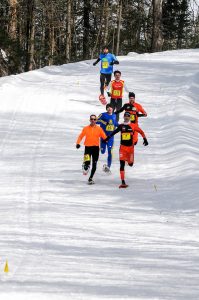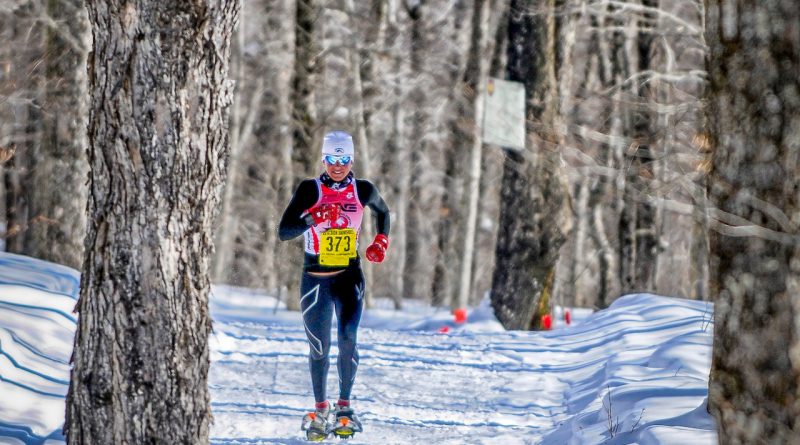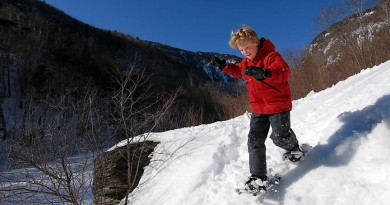Are You Tough Enough? Try 3 Of Winter’s Hardest Races
Snowshoe racing may be the most challenging winter sport out there, but trying it is easy with major races coming to Vermont this winter.
Tim Van Orden is preparing to host one of the biggest snowshoe races in the country at tiny Prospect Mountain in the southwestern corner of Vermont. Every year, the location of the Dion US National Snowshoe Championships rotates between four different areas, and on March 9, the race will land in Woodford for the second time.
According to Van Orden, snow has a lot to do with it. “Prospect Mountain is kind of an anomaly in the Northeast,” he says. “Most mountains in Vermont are in the 2,000-foot range, but this plateau is all above 2,000 feet, and it’s huge. It’s a snow trap.”
Bennington’s less-than-four-hour proximity to Boston, New York City and Montreal makes it a good destination for international travelers, of which the event sees many. At the 2014 championships, held in the same spot, athletes represented 22 states and nine countries.
Attendance at the championships has shot up from about 270 athletes in 2007, when they were held in Syracuse, N.Y., to 413 athletes in Bennington’s first championship in 2014. This year, Van Orden expects 500 participants, the Northeast’s biggest turnout yet.
“Last time, we had a lot of athletes who were new snowshoers, and it opened up the sport to a bigger audience,” he said. “Now, we’re thinking we’ll actually have to put a limit on the number of attendees.”
Among international competitors and renowned runners, Van Orden expects to see Canadian Joël  Bourgeois, a two-time Olympic runner and 1999 winner of the Pan-American Games, Huntington, Vt. native, Vermont City Marathon champ and Salomon-sponsored skyrunner Kasie Enman, and Josh Ferenc, an ultradistance runner from Saxtons River, Vt. competing.
Bourgeois, a two-time Olympic runner and 1999 winner of the Pan-American Games, Huntington, Vt. native, Vermont City Marathon champ and Salomon-sponsored skyrunner Kasie Enman, and Josh Ferenc, an ultradistance runner from Saxtons River, Vt. competing.
This year’s runners can expect an expanded set of races, with marathon and half marathon options. While these options might seem tempting to distance runners, Van Orden warns: “A marathon on snowshoes is probably closer to running a 50-mile race on the road. It’s a different animal.”
GETTING INTO THE SPORT
Vermont has a snowshoeing history: sponsor Dion Snowshoes has been based in Bennington since 1998, and Tubbs Snowshoes was based in Vermont from the 1940s until 2008.
It’s a good time to bring the championships back, as snowshoeing here is on the rise.
Ever since Van Orden first tried snowshoeing, he’s been advocating for other athletes to give the sport a go. “A lot of other sports—running, triathlon, fatbiking—translate well to snowshoeing,” he says.
A competitive Nordic skier (he raced for Middlebury College) and runner (in 2011 he was named both Trail Runner of the Year and Mountain Runner of the Year by USA Masters) Van Orden moved to back to Vermont from Los Angeles in 2007. He wanted to keep himself in shape during the winter, but didn’t want to pay $2,000 for a competitive Nordic setup.
“That’s when a friend told me to try snowshoeing,” he says. “The top-of-the-line snowshoes—the best racing snowshoes you can find—are $200. That’s all you need to buy.”
Getting involved is easy, but the sport itself is not. Van Orden says he’s only run one race harder than a 10K on snowshoes: climbing the stairs of the Empire State Building. During a marathon on snowshoes, runners can easily burn 1,000 calories in an hour.
“I can’t imagine a harder sport. We’ve had people pass out, or just give up and lie down in the snow. It’s every part of your body,” he says. “The snow grabs your shoes, causing you to trip and falter, and it’s hard to get that rhythm. You’re running on top of the snow for three steps, and then you punch in on the fourth. Your whole body gets involved in that. There’s a ton of core, and a ton of upper body. It’s fun.”
Van Orden’s goal is to get newcomers to feel the same way he did when he discovered the sport. “When I tried my first race, it was the hardest thing I’ve ever done,” he said. “And I loved it.”
Those new to snowshoeing can give one of the state’s many 5Ks a try, like the Susan B. Komen Vermont Race for the Cure, which will be held at Stratton on Jan. 21, and the Winter Magic Snowshoe Race around Lowell Lake in Londonderry on Jan. 7.
(See more like this in Calendar, p. 33). At many of these events Tubbs and Atlas will offer snowshoe demos, and you can borrow some for the race. And for those looking to test their endurance, the following snowshoe races are among the toughest there are.
READY FOR A MARATHON?
Frigus | Feb 24
The Endurance Society’s annual snowshoe festival, FRIGUS, will be hosted at the Cortina Inn & Resort this year, with its 5K, 15K and yes, its trademark grueling marathon races. Each race has its own course: the 5K is a single loop, the 15K is a single loop with 1500 feet of vertical, and the marathon will consist of multiple loops, each with 1500 feet of gain. Endurance Society’s Andy Weinberg notes: “We have more climbing in the longer distances, and the longer course will feature rolling wooded trails, a wider and somewhat groomed snowmobile trail section, and a rugged climb with some rocks and ice.” endurancesociety.org
Peak Snowshoe Devil Winter Race, Pittsfield | March 3
If a marathon snowshoe race feels like a 50-mile road race, what does a 100-mile snowshoe race feel like? The aptly-named Devil Winter Race in Pittsfield is a way to find out. Peak Races offers four distances: a 10K, half-marathon, marathon and 100-mile ultra-marathon. Each circles the same 6.5-mile loop with 1,200 feet of vertical, starting with steep flights of stone steps that lead to a winding path on ancient forest roads. Eventually, you emerge at an isolated stone hut with panoramic views of the Green Mountains. The race is named for its threatening descent into “Devil’s Throat,” shortly after the summit, where racers will find chutes and gnarly traverses. If you sign up for the 100-miler, beware: most do not finish this race. peak.com
Dion US National Snowshoe Championships | March 9-11
Prospect Mountain in Woodford, Vt. hosts two days of races. On Saturday, the classic 10K race includes 1200 feet of climbing, with a kilometer of stadium track, then 40 percent groomed Nordic trails and singletrack the rest of the way. A 5K Citizen’s Race will also take place Saturday—great for beginners. New this year, marathon and half marathon races are on Sunday. Both courses are on a 7K loop, shaped like an infinity sign with the aid station at its center. For all races except the 5K Citizen’s Race, runners must be current members of the U.S. Snowshoe Association. ussnowshoechampionships.com
Photos courtesy of Scott Mason


